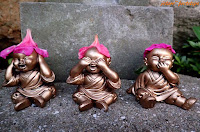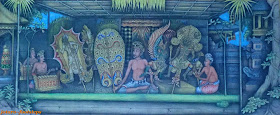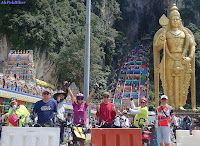You are at - Jotaro's Blog / Footsteps / Art Gallery / Indonesian Art / Balinese Art 2018 / Bali International Airport / Halls 3 & 5 | Go to H4/H6/H7/H8/H9B
Footsteps - Jotaro's Travels
BALINESE PAINTINGS AT BALI INTERNATIONAL AIRPORT: Halls 3 &5 - Balinese Dance Paintings
Bali, Indonesia - November 2018
 |
| Hanuman dancing a Ramayana ritual, preface to the Kecak Dance. |
While on a cycling trip in Bali, on an invitation by the Brompton Owners Bali group, we visited several places. Bali is an island full of art, whether at its attractive temples, palaces, water parks or just around any corner. And we saw many beautiful pieces. even as we were waiting to board our return flight, at the International Departure Halls of the Bali Ngurah Rai International Airport.
Below are some of the paintings that we saw at Halls 3 & 5. Most of the paintings depict traditional Balinese Dance and featured interesting Balinese dance head-wear. As the painting were high up at the tall ceiling level, their are several pieces that came up blur, these I have not included. Click on the respective photo for a better enlarged view. Due to photography angle, and for presentation purposes, many of photos have been cropped and edited to compensate for low lighting. It is better to go there and see these artwork for yourself. Enjoy!
Hanuman in a Kecak Dance.
___________________________________________________________________________________
Below are some of the paintings that we saw at Halls 3 & 5. Most of the paintings depict traditional Balinese Dance and featured interesting Balinese dance head-wear. As the painting were high up at the tall ceiling level, their are several pieces that came up blur, these I have not included. Click on the respective photo for a better enlarged view. Due to photography angle, and for presentation purposes, many of photos have been cropped and edited to compensate for low lighting. It is better to go there and see these artwork for yourself. Enjoy!
This is page 1 of a 6-page blog, Click Here To Go To Main Page.
| Go to Other Halls | Go to Hall 4 >
Traditional Balinese Baris Tumbak Dance.
Joged Bumbung - Balinese Dance from the Jembrana District.
Oleg; Balinese Dance of the Bumblebees.
Oleg is performed by a male and female dancer. It is a dance of love, intended to be evocative of a garden, in which bees are buzzing about, collecting nectar from the waiting flowers.
Balinese "Baris" war dancers.
Baris is a family of traditional war dances of Bali, accompanied by gamelan, in which a dancers depict the feelings of a young warrior prior to battle, glorify the manhood of the triumphant Balinese warrior, and display the sublimity of his commanding presence. Baris literally means line or file, referring to the line of soldiers who served the rajas of Bali.
Balinese Legong Dancers.
Legong is a form of Balinese dance. It is a refined dance form characterized by intricate finger movements, complicated footwork, and expressive gestures and facial expressions.
Traditional Balinese Baris Tumbak Dance.
Joged Bumbung - Balinese Dance from the Jembrana District.
Oleg; Balinese Dance of the Bumblebees.
Oleg is performed by a male and female dancer. It is a dance of love, intended to be evocative of a garden, in which bees are buzzing about, collecting nectar from the waiting flowers.
Balinese "Baris" war dancers.
Baris is a family of traditional war dances of Bali, accompanied by gamelan, in which a dancers depict the feelings of a young warrior prior to battle, glorify the manhood of the triumphant Balinese warrior, and display the sublimity of his commanding presence. Baris literally means line or file, referring to the line of soldiers who served the rajas of Bali.
Balinese Legong Dancers.
Legong is a form of Balinese dance. It is a refined dance form characterized by intricate finger movements, complicated footwork, and expressive gestures and facial expressions.
Hanuman in a Kecak Dance.
The Kecak Dance mainly plays about the Ramayana and is traditionally performed in temples and villages across Bali. Also known as the Ramayana Monkey Chant, the piece, performed by a circle of at least 150 performers wearing checked cloth around their waists, percussively chanting "chak" and moving their hands and arms, depicts a battle from the Ramayana. The monkey-like Vanara led by Hanuman helped Prince Rama fight the evil King Ravana. Kecak has roots in sanghyang, a trance-inducing exorcism.
Rangda, the evil witch dance.
Rangda is the demon queen of the leyaks in Bali, according to traditional Balinese mythology. Terrifying to behold, the child-eating Rangda leads an army of evil witches against the leader of the forces of good - Barong. The battle between Barong and Rangda is featured in a Barong Dance which represents the eternal battle between good and evil. Rangda is a term in old Javanese that means "widow".
A simplified Oleg, using light waist veils to signify wings of the bumblebee.
In fear of Rangda and her evil Leyak spirits.
In the folklore of Bali, the Leyak is a mythological figure in the form of flying head with exposed entrails (heart, lung, liver, etc.) still attached. Leyak is said to fly trying to find a pregnant woman in order to suck her baby's blood or a newborn child. The Malay folklore equivalent of the Leyak is the Hantu Langsuir.
Topeng Balinese Dance.
Rangda is the demon queen of the leyaks in Bali, according to traditional Balinese mythology. Terrifying to behold, the child-eating Rangda leads an army of evil witches against the leader of the forces of good - Barong. The battle between Barong and Rangda is featured in a Barong Dance which represents the eternal battle between good and evil. Rangda is a term in old Javanese that means "widow".
A simplified Oleg, using light waist veils to signify wings of the bumblebee.
In fear of Rangda and her evil Leyak spirits.
In the folklore of Bali, the Leyak is a mythological figure in the form of flying head with exposed entrails (heart, lung, liver, etc.) still attached. Leyak is said to fly trying to find a pregnant woman in order to suck her baby's blood or a newborn child. The Malay folklore equivalent of the Leyak is the Hantu Langsuir.
Topeng Balinese Dance.
Topeng (Indonesian for "mask") is a dramatic form of Indonesian dance in which one or more mask-wearing, ornately costumed performers interpret traditional narratives concerning fabled kings, heroes and myths, accompanied by gamelan music.
Sekar Jempiring Dance.
Sekar Jempiring Dance.
This Balinese cultural dance is the mascot dance from Denpasar city. Created from inspiration of the beauty of color and fragrance of Jempiring flowers. This balinese cultural dance is a welcome dance for a guest in particular event.
A Wayang Kulit master with his kulit shadow puppets.
Wayang Kulit is a traditional performing arts of puppet-shadow play found in the cultures of Java, Bali, and Lombok, in Indonesia. In a wayang kulit performance, the puppet figures are rear-projected on a taut linen screen with a coconut-oil (or electric) light. The Dalang (shadow artist) manipulates carved leather figures between the lamp and the screen to bring the shadows to life.
Giving Balinese blessings during Nyepi.
Nyepi is a Balinese "Day of Silence" that is commemorated every Isakawarsa (Saka new year) according to the Balinese calendar. It is a Hindu celebration mainly celebrated in Bali, Indonesia. Nyepi, a public holiday in Indonesia, is a day of silence, fasting and meditation for the Balinese. The day following Nyepi is also celebrated as New Year's Day. On this day, the youth of Bali in the village of Sesetan in South Bali practice the ceremony of Omed-omedan or 'The Kissing Ritual' to celebrate the new year. The same day celebrated in India as Ugadi.
Observed from 6 a.m. until 6 a.m. the next morning, Nyepi is a day reserved for self-reflection, and as such, anything that might interfere with that purpose is restricted. The main restrictions are no lighting fires (and lights must be kept low); no working; no entertainment or pleasure; no traveling; and, for some, no talking or eating at all. The effect of these prohibitions is that Bali's usually bustling streets and roads are empty, there is little or no noise from TVs and radios, and few signs of activity are seen even inside homes.
Gamelan Music Performers.
Gamelan is the traditional ensemble music of Java and Bali in Indonesia, made up predominantly of percussive instruments. The most common instruments used are metallophones played by mallets and a set of hand-played drums called kendhang which register the beat. Other instruments include xylophones, bamboo flutes, a bowed instrument called a rebab, and even vocalists called sindhen.
This is page 1 of a 6-page blog, Click Here To Go To Main Page.
Related Blogs:
 |
 |
 |
 |
 |
 |
___________________________________________________________________________________
You may also like :
 |
 |
 |
 |
| Art Gallery of New South Wales - 19th Century Australian Art |
You are at - Jotaro's Blog / Footsteps / Art Gallery / Indonesian Art / Balinese Art 2018 / Bali International Airport / Halls 3 & 5 | Go to H4/H6/H7/H8/H9B
If you like this, view my other blogs at Jotaro's Blog
If you like this, view my other blogs at Jotaro's Blog
(comments most welcomed below. if you like this pls share via Facebook or Twitter)














































